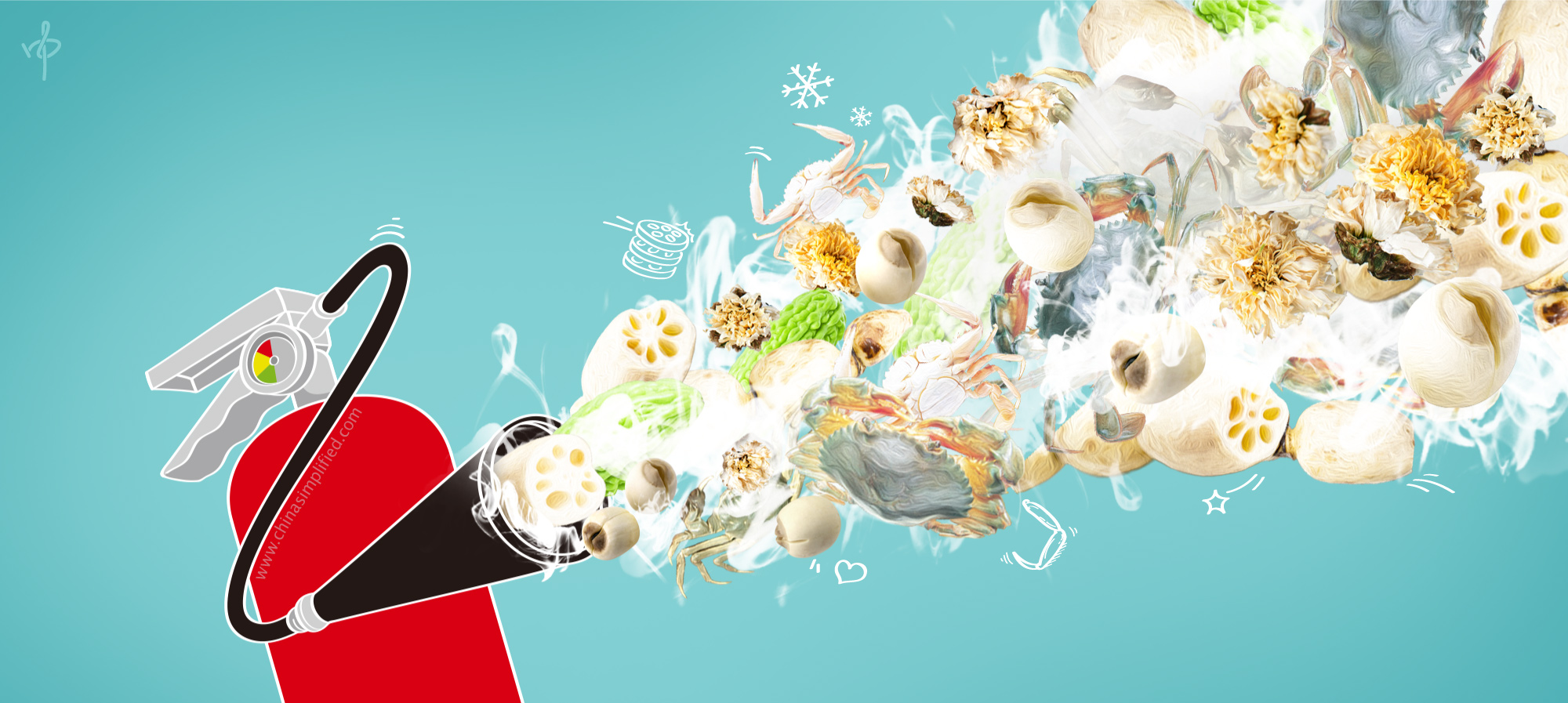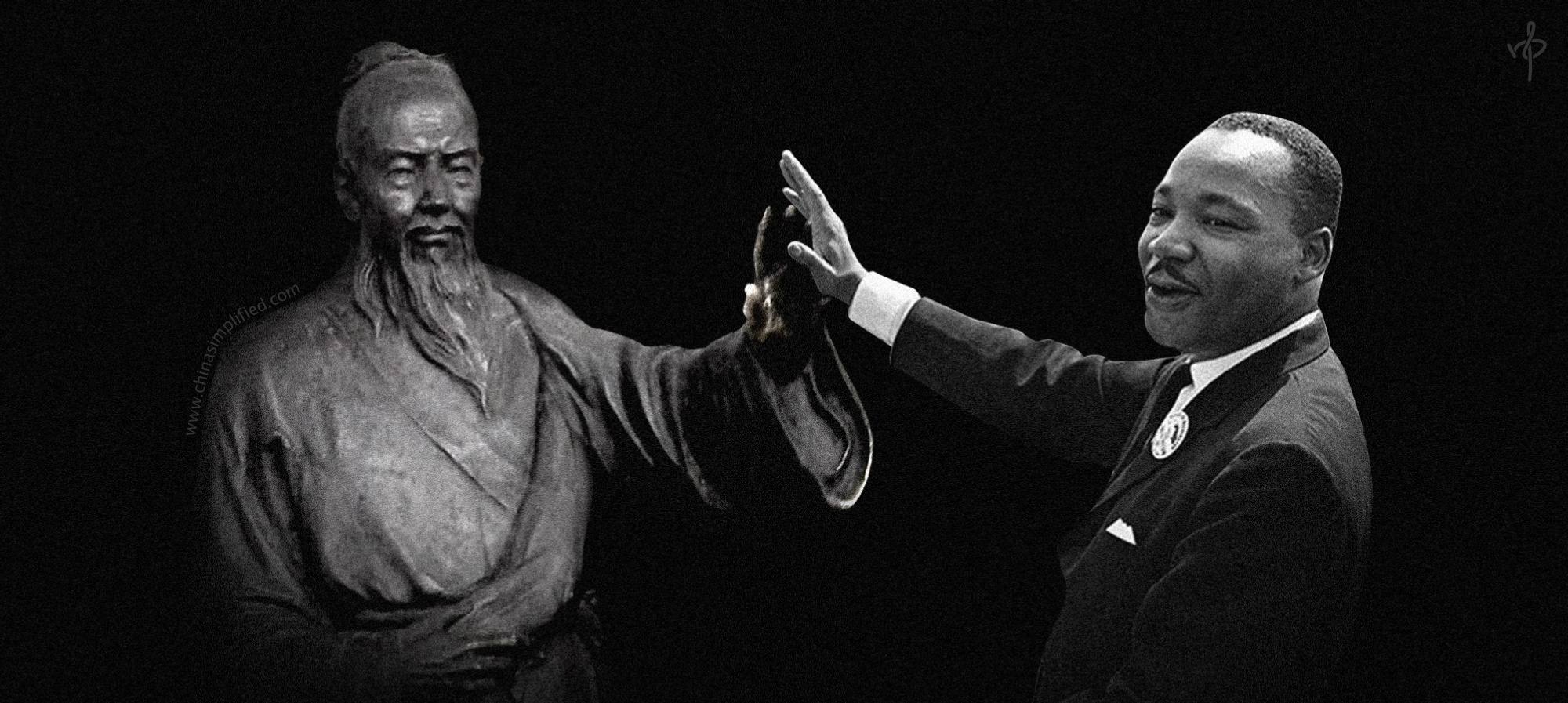Duck is cooling, chicken is heaty. Green tea is cooling, black tea is heaty. Crabs are cooling, shrimp are heaty. To an outsider, these classifications might seem as random as the gender of French nouns, e.g. water is feminine, milk is masculine. What’s a hungry human to do?
A Chinese friend shared a classic incident of pantry shock in her cross-cultural work environment. Her non-Chinese colleague, watching her prepare chrysanthemum tea, asked why she loved it so much. She answered, “It’s a cooling tea to keep me cool and calm.” As she poured boiling water into the cup, her bemused colleague wondered aloud, “How does hot water keep you cool?” The Chinese responded, “The hot water activates its cooling nature.” Ah…right.
Come to think of it, how could a freezing cold mango smoothie possibly be a warming beverage? This really needs more exploration…
The mysteries of ‘heating’ cool drinks and ‘cooling’ hot drinks
Chinese themselves are not born with an innate ability to tell their yīn 阴 from yáng 阳. It’s a learning process through various ulcers, constipations, rashes and other bodily signals, often with an all-knowing mother hovering nearby to dispense her seemingly mystical personal experience:
“The bitter vegetables are good in summer to kill your inner fire.”
“Lamb is too yang for summer; your ulcer will get worse.”
“Stop eating onion (or chicken or chocolate) for a while.”
“Don’t eat more than three crabs; it’s too cooling, you’ll get diarrhea.”
In a perfect world, everyone reaches adulthood instilled with this “mother tongue” of native food guidance and lives happily ever after with their yin and yang in balance.
Meanwhile, many others regard the yin yang nature of foods, like much of Traditional Chinese Medicine (TCM), as too esoteric and unquantifiable, drawing upon ancient beliefs bordering on superstition:
- Yin/cooling energy comes from less motion, while Yang/warming energy comes from more action. For example, a chicken holds more heat than a lamb, and a lamb more heat than a cow.
- Land animals are mostly warming, from their dry environment, while water animals are mostly cooling. And thus, ducks are considered cooling by some, neutral by others.
- Even different body parts of the same pig might be considered yin or yang depending on their function and location.
All of which begs the question: How did these myths of “food therapy” passed along from the Tang Dynasty become such a widely-trusted body balancing system? And more importantly, how can we apply them in our own lives to see if they actually work?
“Food and medicine are not two different things;
they are the front and back of one body.”
– Masanobu Fukuoka
Here are three practical steps anyone searching for an improved yin yang balance may want to consider:
1. Identify your general body tendencies
Every body is different, so it’s not surprising that different foods affect people in different ways. Most people have more yin/cool-leaning or yang/warm-leaning systems, both of which can benefit from minor adjustments. Others can consume plenty of warming foods, such as lamb or mango, without becoming overheated. Clearly this is not a one-size-fits-all methodology.
One of the simplest indicators of people lacking yang, e.g. too much yin, is the feeling their fingertips and toes are hard to keep warm. On the other hand, people with not enough yin, e.g. too much yang, might complain their face easily flushes, or that they feel sweaty even on cool days.
| You may have too much internal fire and need more cooling foods if you have... | You may lack internal fire and need more warming foods if you have... |
|---|---|
| a tendency to feel warm | a tendency for chills |
| discomfort in hot weather | a dislike for cold weather |
| short temper, impatience or irritability | body stiffness, or often feel quiet and withdrawn |
| constipation, rashes, ulcers | watery, loose diarrhea |
| outbreaks of pimples and acne | an overly pale complexion |
| nose bleeds or headaches | a runny nose |
| urine which is too dark | urine which is too clear |
Keep in mind, our bodies can be influenced by temporary conditions such as recent diet, anxiety levels, work fatigue, emotional stress and more. So rather than freaking out at every bodily outbreak or mood swing, why not start keeping a journal to track the specifics of how your body reacts in different situations, including which foods and beverages are better or worse at returning your body to a comfortable energetic balance?
“The food you eat can be either the safest and most powerful form of medicine or the slowest form of poison.”
– Ann Wigmore
2. Eat according to your needs
It sounds like common sense, and it is. Here’s a basic guidance chart:
WARMING | COOLING | NEUTRAL |
|
|---|---|---|---|
| Meat | lamb, shrimp, beef | crab, snake, soft shell turtle | duck* |
| Vegetable | leek, onion, hot pepper | white turnip, green bean, lotus | mushroom |
| Fruit | durian, mango, lychee | papaya, mangosteen, watermelon | apple |
* There are many different heating/cooling food charts out there, many of which are not in agreement(!), which demonstrates the importance of testing all this guidance out for yourself and seeing what works (and doesn’t work) in your own body.
You’ll notice that the best Asian chefs are able to blend the influences of yin yang foods to create balanced dishes bursting with flavor. They’ve also come to master yin yang cooking insights, such as:
- The temperature at which food is served doesn’t necessarily change the cooling or warming nature of food. Shrimp are heating and crabs are cooling, no matter whether served hot or cold, although cooking methods can exert a significant influence.
- The preparation method can have a marked influence on the food, which is why spices and herbs play a large role in Asian cuisine. Chefs often pair ginger and wine (warming) with soft shell turtle. Mangosteen (aka mountain bamboo) gets paired with heaty durian.
- When people overindulge, find ways to offset it. A kettle of strong green tea comes to the rescue after a heavy heaty meal, whereas a bowl of freshly-boiled ginger soup is a life-saver after an excess of cooling food.
We often do this ourselves without even thinking about it, for example, by smearing sashimi with wasabi, or cooking tofu with chilies.
Warming methods | Cooling/neutral methods |
|---|---|
| Cooking with hot spices | Blanching |
| Cooking with alcohol | Steaming |
| Grilling | Boiling in plenty of water |
| Frying and roasting in oil | Salt fermentation |
| Baking | Preparation with fruit |
| Smoking | Sprouting |
| Roasting/wok cooking | Eating raw |
| Long simmering |
Source: “Chinese Dietary Therapy in Clinical Practice” by Graeme McCracken, Journal of Chinese Medicine.
In a nutshell, don’t overdo it. See what works for you and strive for long term balance.
3. Strive for seasonal adjustments
Varying climates and seasons have a profound impact on the plants and animals we consume, so why would their influence on our bodies be any different?
TCM practitioner Wang Yuxiang writing in Vitality Magazine discusses seasonal food selection principles and describes a TCM Change of Season Diet. She believes the most important principle of healthy eating is to keep in harmony with one’s natural Qi and inner physiological cycle, while remaining flexible according to specific body constitution, age and conditions under treatment.
“Let food be thy medicine and medicine be thy food.”
– Hippocrates
Final Thoughts
Chinese and Western medicine have progressed in parallel over the centuries, yet they share the same goal: to prevent and cure disease, enabling good health and longevity.
“We must admit that our knowledge is limited while the unknown world is limitless,” notes Cheung Taichiu in his academic discussion in the Chinese Journal of Integrated Traditional and Western Medicine. “TCM and Western medicine should and surely can develop and progress side by side.” Both have their advantages, and disadvantages.
There’s no doubt that what we choose to put into our bodies plays an important role, if not the biggest role, in determining our overall well-being. From this perspective, for Westerners to dismiss out of hand as superstition an Eastern food therapy system being documented for over two thousand years, flawed and inconsistent as it may be, seems foolhardy indeed.
As Laozi once observed, “Not-knowing is true knowledge; presuming to know is a disease.”
Common Sense Disclaimer: We’re not doctors so please don’t take this as medical advice. Do your research, and seek professional guidance where necessary.
That said, we’d love to hear about your own experiences with yin yang food properties in the comments area below, so that others may benefit from what you’ve learned.










I’m so happy to find this system I fixed the issue of cold hands and feet by incorporating more spices and black tea.
Among my weirder accomplishments, I have a Neilsen’s Ice Cream soda-jerk qualification from over sixty years ago.
What’s relevant here is that on page one or the text they (quite plausibly) told us, here in Canada, that an ice-cream cone contained more calories than a bowl of hot soup, something we were to tell customers all winter, I guess…
-dlj.